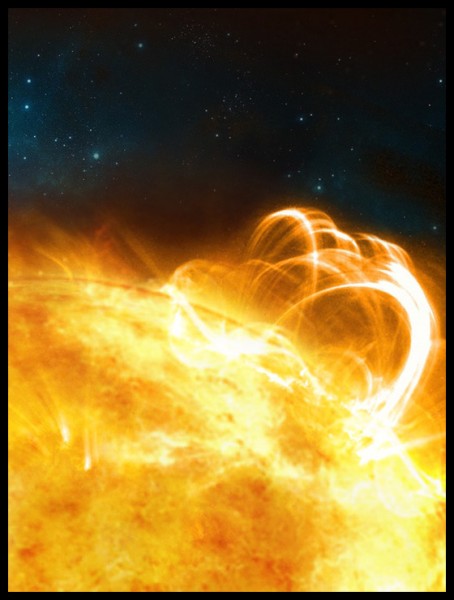Evidence that our Sun could release ‘superflares’ 1000x greater than previously recorded
December 2, 2015

What the Sun might look like if it were to produce a superflare. A large flaring coronal loop structure is shown towering over a solar active region. (credit: University of Warwick/Ronald Warmington)
Astrophysicists have discovered a stellar “superflare” on a star observed by NASA’s Kepler space telescope with wave patterns similar to those that have been observed in the Sun’s solar flares. (Superflares are flares that are thousands of times more powerful than those ever recorded on the Sun, and are frequently observed on some stars.)
The scientists found the evidence in the star KIC9655129 in the Milky Way. They suggest there are similarities between the superflare on KIC9655129 and the Sun’s solar flares, so the underlying physics of the flares might be the same.
Disastrous for life on Earth
Typical solar flares can have energies equivalent to a 100 million megaton bombs, but a superflare on our Sun could release energy equivalent to 100 billion megaton bombs, the scientists say.
The effects on the power grid in the U.S. would be similar to those resulting from a major cyberattack on America’s power grid, as described in the just-published book, Lights Out: A Cyberattack, A Nation Unprepared, Surviving the Aftermath.
The Earth’s communications and energy systems could be at serious risk of failing, the scientists note, and disastrous for life on Earth. Our GPS and radio communication systems could be severely disrupted and there could be large-scale power blackouts as a result of strong electrical currents being induced in power grids.
The evidence
Research co-author Anne-Marie Broomhall, PhD, from the University of Warwick explains: “When a flare occurs, we typically see a rapid increase in intensity followed by a gradual decline. Usually the decline phase is relatively smooth but occasionally there are noticeable bumps, which are termed ‘quasi-periodic pulsations’ or QPPs.”
The scientists used techniques called wavelet analysis and Monte Carlo modeling to assess the periodicity and statistical significance of these QPPs. The analysis revealed two significant periodicities, with less than a 1% probability that these pulsations would be observed by chance. The most plausible explanation for the presence of two independent periodicities: the QPPs were caused by magnetohydrodynamic (MHD) oscillations, which are also frequently observed in solar flares, the scientists say.
“This result is, therefore, an indication that the same physical processes are involved in both solar flares and stellar superflares. The latter finding supports the hypothesis that the Sun is able to produce a potentially devastating superflare.”
(Also see previous KurzweilAI coverage of this subject.)
The research is published by The Astrophysical Journal Letters and was funded by the European Research Council.
Abstract for A Multi-Period Oscillation In A Stellar Superflare
Flares that are orders of magnitude larger than the most energetic solar flares are routinely observed on Sun-like stars, raising the question of whether the same physical processes are responsible for both solar and stellar flares. In this Letter, we present a white-light stellar superflare on the star KIC 9655129, observed by NASA’s Kepler mission, with a rare multi-period quasi-periodic pulsation (QPP) pattern. Two significant periodic processes were detected using the wavelet and autocorrelation techniques, with periods of 78 ± 12 minutes and 32 ± 2 minutes. By comparing the phases and decay times of the two periodicities, the QPP signal was found to most likely be linear, suggesting that the two periodicities are independent, possibly corresponding either to different magnetohydrodynamic (MHD) modes of the flaring region or different spatial harmonics of the same mode. The presence of multiple periodicities is a good indication that the QPPs were caused by MHD oscillations and suggests that the physical processes in operation during stellar flares could be the same as those in solar flares.